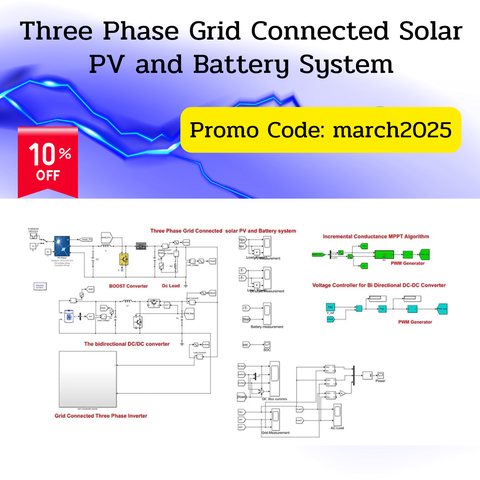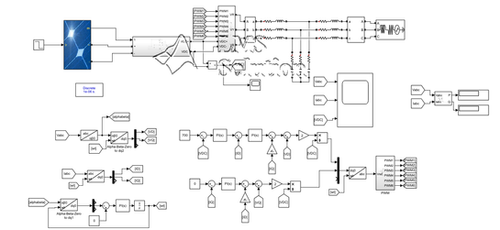
MATLAB - Grid Connected 100 kW Solar PV system | LMS Solution
A 100-kW PV array is connected to a 0.4 kV grid via a DC-DC boost converter and a three-phase three-level Voltage Source Converter (VSC). Maximum Power Point Tracking (MPPT) is implemented in the boost converter by means of a Simulink® model using the 'PO + Proportional Integral Regulator' technique. The detailed model contains the following components: PV array delivering a maximum of 100 kW at 1000 W/m^2 sun irradiance. 5-kHz DC-DC boost converter increasing voltage from PV natural voltage (290 V DC at maximum power) to 700 V DC. The switching duty cycle is optimized by an MPPT controller that uses the 'Incremental Conductance + Integral Regulator' technique. This MPPT system automatically varies the duty cycle in order to generate the required voltage to extract maximum power. 1980-Hz 3-level 3-phase VSC. The VSC converts the 700 V DC link voltage to 230 V AC and keeps the unity power factor. The VSC control system uses two control loops: an external control loop that regulates DC link voltage to +/- 250 V and an internal control loop that regulates Id and Iq grid currents (active and reactive current components). Id current reference is the output of the DC voltage external controller. Iq current reference is set to zero in order to maintain the unity power factor. Vd and Vq voltage outputs of the current controller are converted to three modulating signals Uabc_ref used by the PWM Generator. The control system uses a sample time of 100 microseconds for voltage and current controllers as well as for the PLL synchronization unit. Pulse generators of Boost and VSC converters use a fast sample time of 1 microsecond in order to get an appropriate resolution of PWM waveforms.

Demand-side management in Grid-Connected Battery System using Neural Network | LMS Solution
Demand-side management in Grid-Connected Battery System using Neural Network A novel energy management system to improve the efficiency of grid-connected energy storage systems using a deep neural network is developed. The high penetration of renewable energy and decentralization of the grid has led to an increase in the instability of the grid. To reduce this instability, a balance between the consumption demand and production rate needs to be maintained. For this objective, electric vehicle batteries can be integrated with demand-side management techniques using a deep neural network. The controller can be programmed with the timing of the peak and the off-peak hours obtained from the demand curve data and state of charge of the battery. The controller will take two inputs: The time of the day and the State of Charge of the battery. The NN controller will detect the arrival of the peak and will send a message to the EV battery to supply a programmed percentage of power to the household appliances. The direct communication between the grid and the battery can be eliminated to reduce the infrastructure requirements and data processing. The grid can operate successfully during normal working hours and can supply the total power consumption by the loads at any time of the day. The peak to average power ratio can be reduced by operating the EV battery during peak hours for providing that programmed percentage to the appliances for better grid operation. This drained battery will be further fully charging during low loading of the grid and keep ready for the following days’ operation. According to the results of simulation studies, it is demonstrated that our proposed model not only enhances users’ utility but also reduces energy consumption costs.
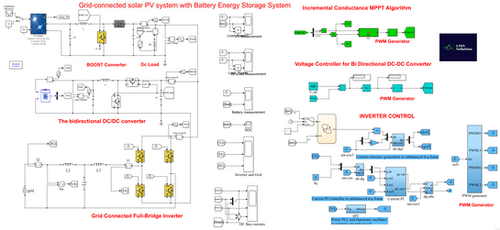
Grid-connected solar PV system with Battery Energy Storage System | LMS Solution
The penetration of renewable sources in the power system network in the power system has been increasing in recent years. These sources are intermittent in nature and their generation pattern does not match the load pattern thereby creating a need for a battery storage system. In this context, energy management presents itself as an inevitable challenge in operating grid-connected distributed renewable sources. The challenge is due to factors such as intermittency of source, time of the day prices, sizing of solar panels and battery, limitations of charging and discharging rates of the battery. In this work, one of the solutions being proposed to improve the reliability and performance of these systems is to integrate energy storage devices into the power system network. This work discusses the modeling of photovoltaic and the status of the battery storage device for better energy management in the system. The energy management for the grid-connected system was performed by the dynamic switching process. The optimal selection of a number of solar panels, battery size has also been presented. The proposed algorithm helps in effectively deriving the potential benefits of a grid-connected rooftop solar system with battery storage.
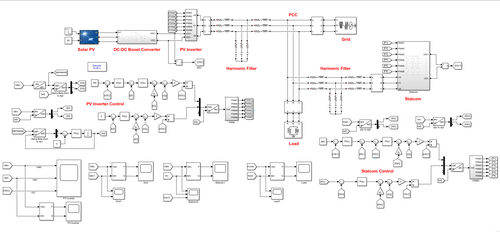
Reactive Power Compensation in Grid Connected PV Using STATCOM & Fixed capacitor | LMS Solution Inter
Reactive Power Compensation in Grid Connected PV System Using STATCOM and Fixed Capacitor Integration of Distributed Energy Resources (DER) in conventional power system has increased all over the world. The main aim of connecting DERs is to fulfill supply demand gap at the same time they can be used for ancillary services like reactive power support. Conventionally equipment’s like fixed capacitors are being used for reactive power compensation and power quality improvement. STATic COMpensators (STATCOM) have been lately used for dynamic reactive power compensation. This work focuses upon integration of solar PV with STATCOM and fixed capacitor for reactive power compensation as well as the active power sharing with grid. Control technique called dq algorithm has been implemented for the control of the STATCOM.
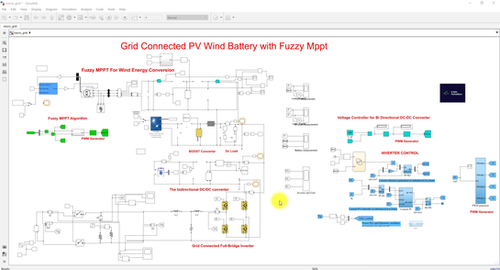
Grid connected PV Wind and Battery with Fuzzy MPPT | LMS Solution
Grid connected PV Wind and Battery with Fuzzy MPPT This work explains the working of grid connected pv wind and battery with fuzzy mppt in matlab simuilation.
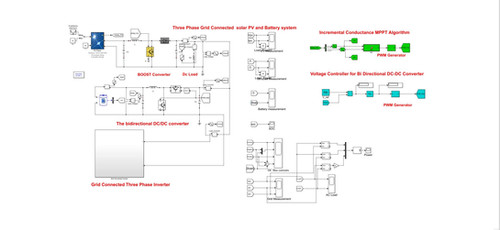
Three Phase Grid Connected solar PV and Battery system | LMS Solution
Three Phase Grid Connected solar PV and Battery system This work explains the three-phase grid-connected solar PV with a battery energy storage system. and also discussed maximum power point tracking (mppt), voltage control of battery converter, and current control of inverter with the DQ control method.

Grid-connected solar PV system with Battery Energy Storage System | LMS Solution
The penetration of renewable sources in the power system network in the power system has been increasing in recent years. These sources are intermittent in nature and their generation pattern does not match the load pattern thereby creating a need for a battery storage system. In this context, energy management presents itself as an inevitable challenge in operating grid-connected distributed renewable sources. The challenge is due to factors such as intermittency of source, time of the day prices, sizing of solar panels and battery, limitations of charging and discharging rates of the battery. In this work, one of the solutions being proposed to improve the reliability and performance of these systems is to integrate energy storage devices into the power system network. This work discusses the modeling of photovoltaic and the status of the battery storage device for better energy management in the system. The energy management for the grid-connected system was performed by the dynamic switching process. The optimal selection of a number of solar panels, battery size has also been presented. The proposed algorithm helps in effectively deriving the potential benefits of a grid-connected rooftop solar system with battery storage.

Grid connected and Islanded mode operation of Microgrid | LMS Solution
Grid connected and Islanded mode operation of Microgrid This work explains the grid-connected and islanded mode operation of the microgrid. the microgrid consists of solar PV, wind, and battery storage. simulation results of grid mode and island mode explained for microgrid in matlab.

MATLAB - Grid Connected 100 kW Solar PV system | LMS Solution
A 100-kW PV array is connected to a 0.4 kV grid via a DC-DC boost converter and a three-phase three-level Voltage Source Converter (VSC). Maximum Power Point Tracking (MPPT) is implemented in the boost converter by means of a Simulink® model using the 'PO + Proportional Integral Regulator' technique. The detailed model contains the following components: PV array delivering a maximum of 100 kW at 1000 W/m^2 sun irradiance. 5-kHz DC-DC boost converter increasing voltage from PV natural voltage (290 V DC at maximum power) to 700 V DC. The switching duty cycle is optimized by an MPPT controller that uses the 'Incremental Conductance + Integral Regulator' technique. This MPPT system automatically varies the duty cycle in order to generate the required voltage to extract maximum power. 1980-Hz 3-level 3-phase VSC. The VSC converts the 700 V DC link voltage to 230 V AC and keeps the unity power factor. The VSC control system uses two control loops: an external control loop that regulates DC link voltage to +/- 250 V and an internal control loop that regulates Id and Iq grid currents (active and reactive current components). Id current reference is the output of the DC voltage external controller. Iq current reference is set to zero in order to maintain the unity power factor. Vd and Vq voltage outputs of the current controller are converted to three modulating signals Uabc_ref used by the PWM Generator. The control system uses a sample time of 100 microseconds for voltage and current controllers as well as for the PLL synchronization unit. Pulse generators of Boost and VSC converters use a fast sample time of 1 microsecond in order to get an appropriate resolution of PWM waveforms.

Demand-side management in Grid-Connected Battery System using Neural Network | LMS Solution
Demand-side management in Grid-Connected Battery System using Neural Network A novel energy management system to improve the efficiency of grid-connected energy storage systems using a deep neural network is developed. The high penetration of renewable energy and decentralization of the grid has led to an increase in the instability of the grid. To reduce this instability, a balance between the consumption demand and production rate needs to be maintained. For this objective, electric vehicle batteries can be integrated with demand-side management techniques using a deep neural network. The controller can be programmed with the timing of the peak and the off-peak hours obtained from the demand curve data and state of charge of the battery. The controller will take two inputs: The time of the day and the State of Charge of the battery. The NN controller will detect the arrival of the peak and will send a message to the EV battery to supply a programmed percentage of power to the household appliances. The direct communication between the grid and the battery can be eliminated to reduce the infrastructure requirements and data processing. The grid can operate successfully during normal working hours and can supply the total power consumption by the loads at any time of the day. The peak to average power ratio can be reduced by operating the EV battery during peak hours for providing that programmed percentage to the appliances for better grid operation. This drained battery will be further fully charging during low loading of the grid and keep ready for the following days’ operation. According to the results of simulation studies, it is demonstrated that our proposed model not only enhances users’ utility but also reduces energy consumption costs.





